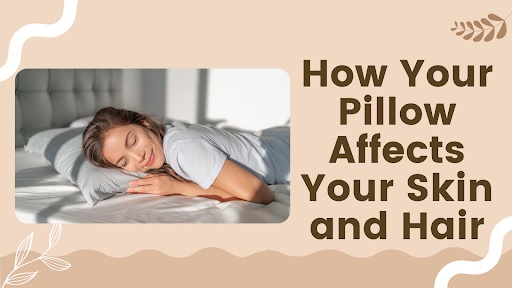Your pillow is your refuge – the soft, cushy cloud that cradles your head after a long day. But did you know that your pillow could secretly be damaging your skin and hair?
It’s time to find out the hidden dangers of your pillow and how to counter them. This article will uncover the surprising ways your pillowcase and sleep habits impact your skin and hair health.
In this article let us see the effects of pillowcases on your skin and hair.
The Hidden Risks of Your Pillow.
Daily around 6-8 hours on average people sleep on the cushion which is covered by the pillowcase, your pillowcase tends to have a thriving community of bacteria that can wreak havoc on your skin.
According to a study, it is shown that using a pillowcase for more than a week gradually increases the bacteria count of your pillow. These bacteria harm your skin health and hair growth.
Pillowcases and Skin Health
Most of them hold the same pillowcase for many years. Every 1-2 years you need to change your pillowcases because our pillows are far longer, allowing dead skin cells, body oils, and bacteria to gather. This creates the perfect breeding ground for clogged pores, acne breakouts, and other skin issues.
In order to avoid bacterial growth on your pillowcase, altering them like washing or replacing them every few days can prevent bacterial growth. This leads to a safer environment to sleep in.
So while polyester may be wrinkle-free, cotton pillowcases are the clear winner for skin health. Luxury pillows like those from Eli & Elm use high-quality cotton combined with mulberry silk for pillowcases that are gentle on the skin while resisting wrinkles. Going for a polyester pillow case has a warm nature thus it actually provides a better environment for bacteria to multiply and increase their number.
So, it’s evident that cotton pillowcases are a better choice than polyester pillowcases.
How are Sleep Positions and Skincare Related?
Did you know that your preferred sleep position could be contributing to wrinkles? Sleeping face-down smushes your face into the pillow, which can etch lines into the skin over time.
The friction and pressure against your pillow rubs away your skin’s collagen and elastic fibers, two components that keep skin plump and supple. Chronic sleep wrinkles often form on the chest, neck, and cheeks.
Certain pillow materials, like polyester, may worsen these wrinkles because they generate more friction against the skin’s surface. Silk and satin pillowcases are praised for their wrinkle-reducing properties. Their ultra-smooth texture allows your skin to glide freely, without tugging at the delicate facial skin.
Regardless of the material, sleeping on your back is the best position to avoid premature wrinkling. If you can’t give up your stomach sleeping, try to choose smoother pillow fabrics and change your case frequently to avoid a buildup of skin cell debris.
The Absorption of Skin Care Products by Your Pillow
Following up on perfect skincare like applying moisturizers, retinol, night cream, etc., is a good practice to take care of your skin, What if they failed to benefit you? Even the product actually works amazingly on your skin, after you applied them on your skin during the night if you are going to bed it would cause rubbing and pressing on your pillowcases,
Here are some tips to prevent your skincare routine from being not absorbed in your skin:
- For full absorption by your skin, just wait for 30 minutes after applying the products.
- Always go for lighter moisturizers and serums at night, which absorb quicker.
- Use a silk or satin pillowcase, which won’t soak up products as quickly.
- Sleep on your back to avoid rubbing your face on the pillow.
With some small adjustments, you can ensure your luxurious creams and serums work their magic overnight.
Potential Skin Irritations from Your Pillow
Apart from clogged pores and wrinkles, Pillow covers also cause skin irritations by buildup of oils, dead skin, dust mites, and bacteria within your pillow may trigger contact dermatitis – an itchy rash reaction on the skin.
These allergens can also provoke an itchy and flaky scalp. As you shed skin cells onto your pillow each night, the debris mixes with oils to clog your hair follicles. This leads to inflammation, redness, and pesky dandruff flakes. To reduce irritation, dermatologists recommend replacing your pillow every 12-18 months and washing pillowcases twice a week. Allergy-proof covers can also help deter dust mites.
A clean, fresh pillow is vital for keeping your complexion calm and your scalp flake-free.
The Effect of Your Pillowcase on Hair Health
Just like your skin, your hair suffers damage from friction and oils overnight. If you notice more hair than usual on your pillowcase or brush, your pillow may be causing some excess breakage.
The silky cotton fibers of your pillowcase snag onto hair strands, creating friction, tangling, and weakened areas prone to snapping. This damage is intensified if you sleep with your hair in a loose ponytail or braid. The extra contact with the pillowcase tugs and pulls at the hair.
Satin and silk pillowcases are the best choice for protecting hair overnight. Their ultra-smooth texture allows strands to glide freely without friction or snagging.
If you don’t want to splurge on a new pillowcase, here are some other tips for avoiding hair damage:
- Use a loose scrunchie or claw clip at night, rather than hair ties or elastics which can stress the hair.
- Try a slippery leave-in conditioner to reduce friction.
- Change your pillowcase twice a week to limit oils and buildup.
With some thoughtful strategies, you can ward off pillow-induced hair woes.
Conclusion
Who knew that your pillow could play such an important role in the health of your skin and hair? But a few thoughtful changes like switching materials, cleaning more frequently, and adjusting sleep position can help safeguard your complexion and strands.
Give your pillowcase a little extra TLC and it will return the favor with glowing skin and lustrous locks. Here’s to waking up with hair like a Disney princess and skin like a supermodel!
Frequently Asked Questions(FAQ)
- How often should I change my pillowcase to maintain skin health?
Dermatologists recommend changing your pillowcase every 2-3 days for optimal skin health. This helps reduce the buildup of dirt, oils, and bacteria that clogs pores. If you struggle with frequent acne, try changing them daily.
- What type of pillowcase is best for preventing hair damage?
Silk or satin pillowcases create the least friction against hair strands. Cotton cases tend to be more absorbent but rougher in texture, making them more prone to tugging and breaking hair as you sleep.
- Are there specific pillows or pillowcases recommended for those with sensitive skin?
Hypoallergenic pillows and allergen-proof covers** can help reduce irritation and allergic reactions. Bamboo pillowcases are also praised for being extremely soft, breathable, and antimicrobial. In general gentler fabrics like cotton and silk cause less irritation for sensitive skin types.



